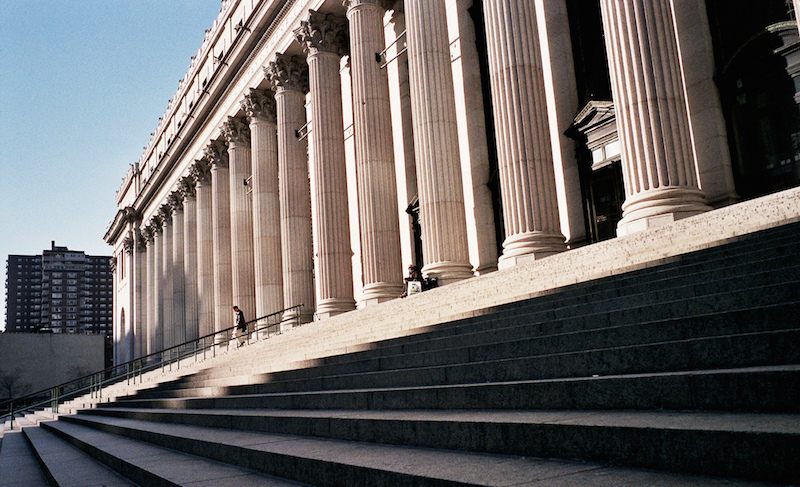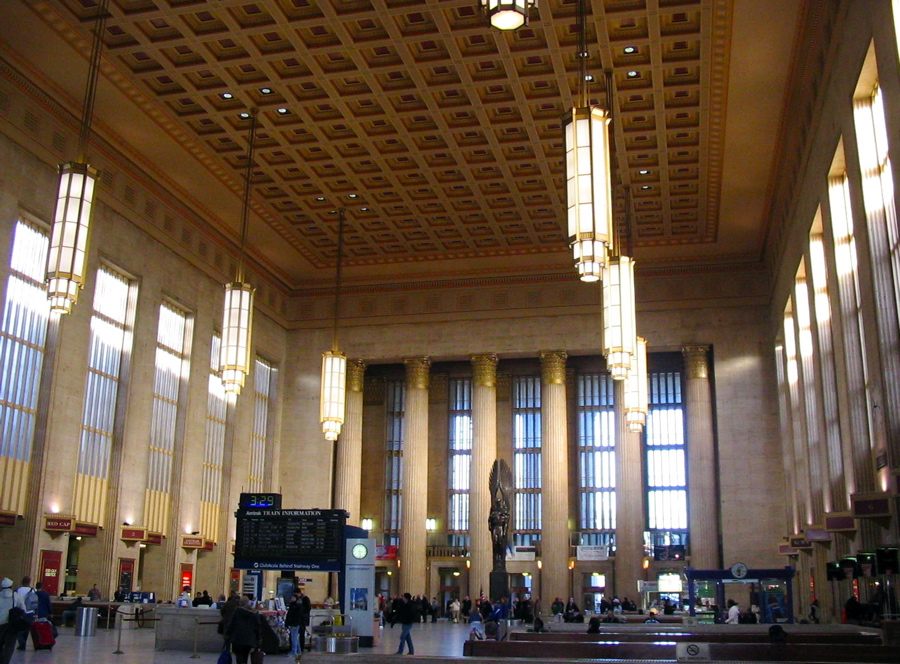What Does It Take to Rename a Building?

The James A. Farley Post Office (Image: Charley Lhasa/Flickr)
The decision to change the name of the United States’ busiest rail station was made in a day.
On March 26, 2003, former Senator Daniel Patrick Moynihan died. For years, Moynihan had been pushing to expand Penn Station into the building next door, the Farley Building. Originally used as a post office, it’s a soaring, grand space designed by the same team that had created the original Penn Station, long since lost to mid-century urban development.
When Moynihan died, his plan to annex the Farley Building as part of New York’s central station was just starting to gain traction. And at that time, one of his closest aides, Kevin Sheekey, was working in the mayor’s office in New York City. Quickly, he put together a deal, and on March 27, Michael Bloomberg, then just two years into his 12 year mayoralty, announced that, one day, when the train station expanded, “We will honor [Sen. Moynihan’s] larger than life dreams and their ultimate realization by naming the Daniel Patrick Moynihan Station in his memory.”
More than a decade later, though, there is no building (or even part of a building) named Moynihan Station. What’s the hold up? How do you rename a building, anyways?

Inside the 30th Street Station in Philadelphia, another renaming imbroglio. (Photo: By Cornellrockey/CC BY-SA 2.5)
The main ingredient in changing a building’s names seems to be the will to do so. In theory, since there are few formal laws governing the process, it should be relatively simple. But in practice, in some cases, it can be much more complicated. If a building is named at all, that name is usually tied up with either money or honor. And those connections can be tricky to undo.
Any building that’s being re-named, first of all, is likely to have more than its fair share of love and money invested into it. Most buildings don’t have or need or want names. But there are certain places in the world that named buildings occur more frequently: on the shore or along a mountain lake, on college campuses, along the poshest streets of New York City. The names of vacation homes might denote pride, or a terrible talent for puns (SEA-esta, Wild Thyme, All Decked Out, Breeze On Inn, Just Beachy, Knot 4 Sail). In the highest end of high rises, they are a marketing tool, agreed upon by a committee of developers who want to make potential buyers feel like they’ll be living somewhere special. (Rutherford Stuyvesant pioneered the idea when he introduced apartment housing to the upper class in 1869.)
For private buildings, the naming process is simple enough: pick one, and tell people that’s what the building is called. The process of picking might take awhile, but once a name has been settled on, there are few barriers to execution. Get a sign made, carve it in stone above the entrance, print up some marketing materials, and hope it catches on.
This all gets more complicated when some combination of nostalgia, money, ego or politics enters in. On college campuses, buildings are often named after a person who donated a large amount of money to its construction or renovation. But how long does that gift hold for? What if the building needs to be renovated again, 20 years later? What if the person who the buildings was named after was a terrible racist or a defender of human slavery? No matter what, as UNC law professor Alfred Brophy writes, “expectations have grown around a name and any such move invites, at the very least, confusion and lost goodwill.” (No one’s saying you can’t rename your grandparents’ beachhouse with your own very clever idea, but probably you’re going to fight with some distant cousins about it at the next family reunion.)
Renaming a government building has another layer of complication. Usually, the name needs to be approved by a governmental body. Naming a county courthouse, for instance, often requires a vote from a county legislature. Recently, both in Philadelphia and in Washington, D.C., politicians have tried to rename train stations that are owned by the federal government, which requires Congress to pass a bill. The push to rename 30th Street Station “William H. Gray III 30th Street Station” after a local political legend went through. (One headline: “Train Geeks Freaking Out Over 30th Street Renaming.) The push to rename Washington’s Union Station after Harry Truman did not.
Whenever a building is renamed, there’s also the question of what people will actually call it. The building that could one day be the primary regional rail terminal for New York City is officially, today, the James A. Farley Post Office. Tell a New Yorker to meet you at the Farley Post Office, though, and you’d probably get a blank stare.

One day, Moynihan Station, maybe? (Image: H Finkelstein & Son/Wikimedia)
The Penn Station mystery name situation has complexities most other names don’t have to contend with. For starters, this building officially already has more than one identity. In 1973, it was listed on the National Register of Historic Places. On that list, says Alexis Abernathy, who works on the National Register, “it’s called the U.S. General Post Office.” That’s the name it had at the time it was listed and no matter what anyone does in the present or future, “that’s what it’ll stay listed as.” It was renamed the James A. Farley Post Office in 1982, after a local politician and postmaster. At the time, the building was owned by the federal government, which means Congress would have had a hand in the name change.
Since 2007, though, the building has been owned by New York’s Empire State Development Corporation. In 2003, the deal was in the works, and there existed a state-run “Penn Station Development Corporation.” That name was changed, within a year or so, to “Moynihan Station Development Corporation.”
But naming any train-related place out in the real world of Midtown Manhattan after Daniel Patrick Moynihan has proven a much longer process. “It’s not yet clear what the scope of the renaming is—what’s actually going to be renamed Moynihan Station,” says Dan Schned, a senior planner at the Regional Plan Association, connected to the group Friends of Moynihan Station. Part of the difficulty is that it’s not still clear what the expansion of Penn Station will look like, how it will work, or when it’ll be complete. “At this time there is no plan to change the name of the historic James A. Farley building,” an Empire State Development official said, in a statement.
The bottom line, for most New Yorkers, though, has nothing to do with the name. Free us from the crowded and badly lit halls of the current Penn Station, and we’ll call the new train station whatever anyone tells us to.



Follow us on Twitter to get the latest on the world's hidden wonders.
Like us on Facebook to get the latest on the world's hidden wonders.
Follow us on Twitter Like us on Facebook